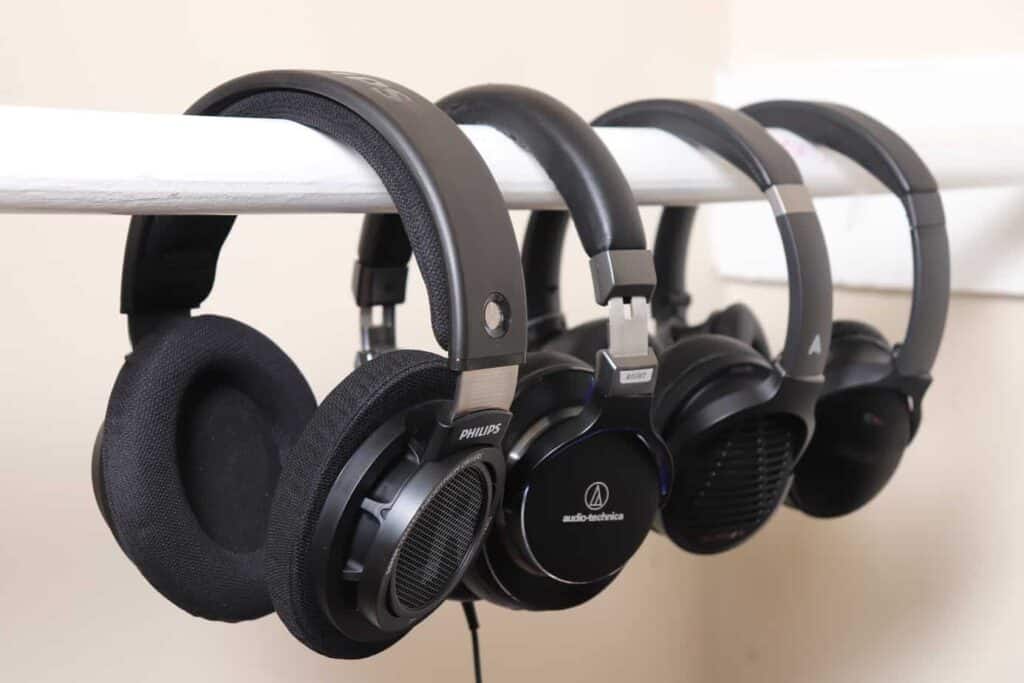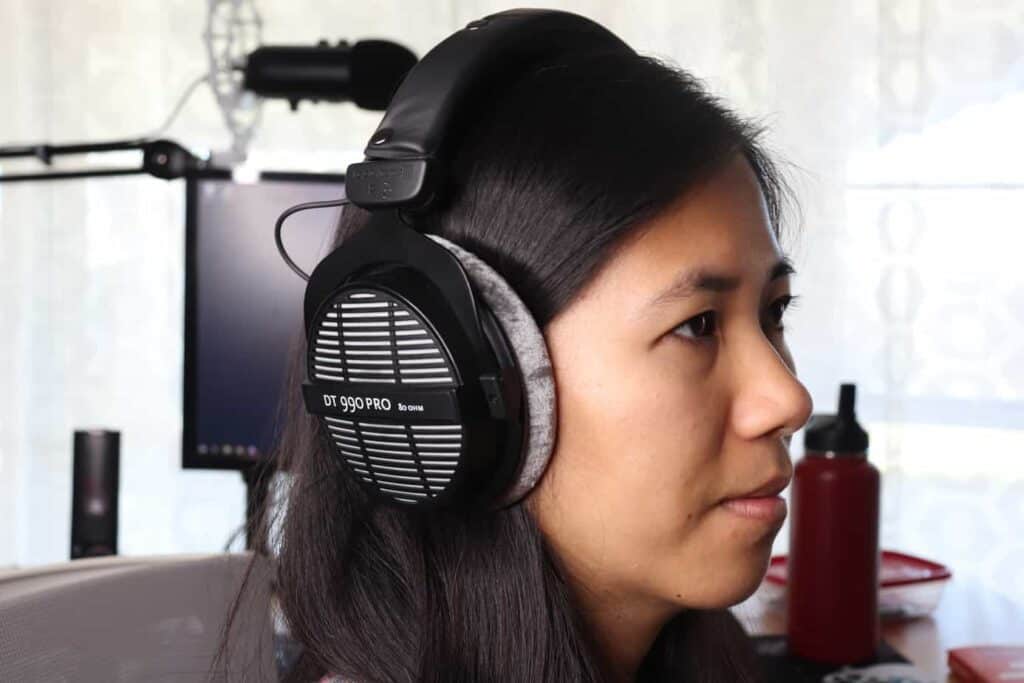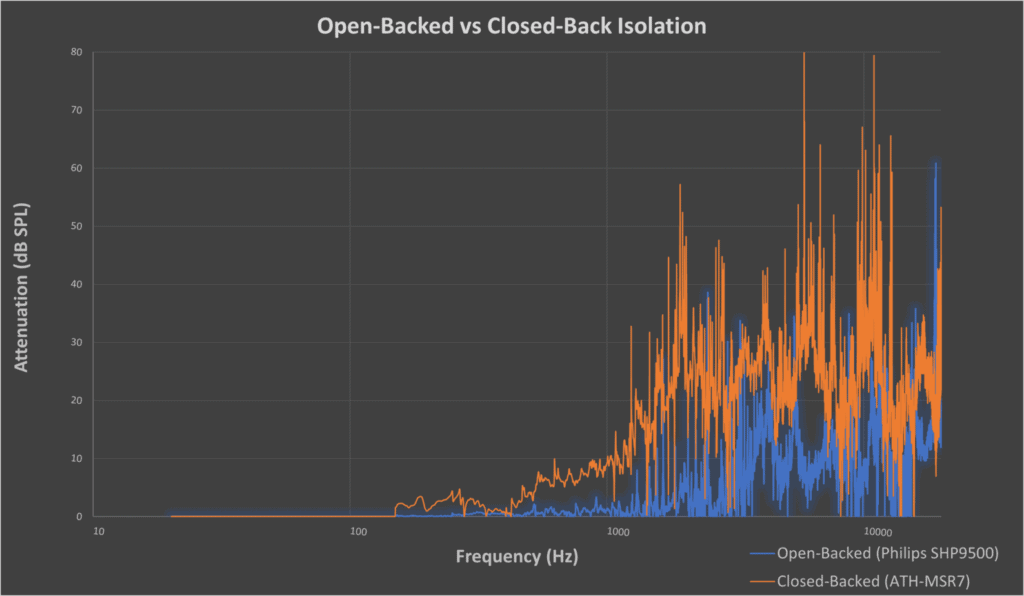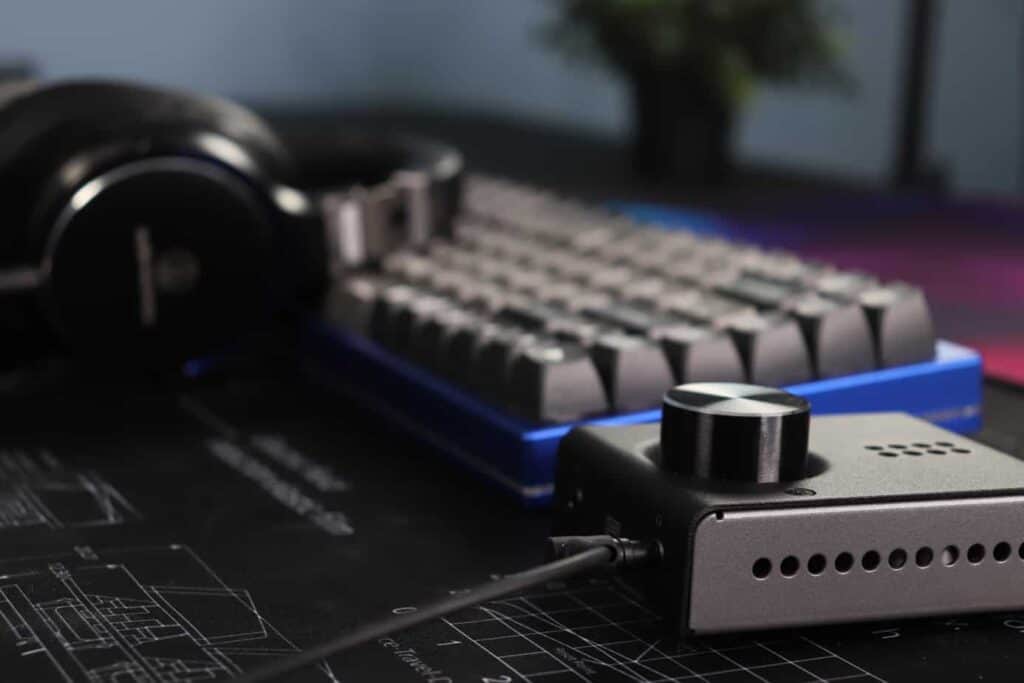When I picked up my first pair of open-backed headphones I was thrilled by the wider soundstage and revamped listening experience.
My excitement was quickly curtailed by complaints from my wife, who wasn’t exactly thrilled that she too, could listen to my music.
The question is, exactly how much sound do open-backed headphones leak?
There is a 30dB increase in sound leakage with open-backed headphones compared to closed-backed. By design, open-backed headphones let air pass through the ear cups to improve the listening experience of user and provide a wider soundstage.
At normal listening levels, people in your immediate proximity can hear your music.
In order to get actual data, we tested the sound leakage on open-backed headphones in a variety of different situations and compared them against closed-back headphones.
Sound Leakage: Open-Backed vs Closed-Back

In theory, open-backed headphones should leak much more than closed-back due to how the soundstage is formed.
In order to figure out the exact amount of leakage, we conducted a test. First, we did a subjective test where my wife would rate the sound leakage when standing from different distances.
Then we looked at other data and gathered the exact decibel measurements to figure out the sound leakage.
The Sound Leakage Test
For this test, I played music through my open-backed headphones and my wife would stand different distances away from me.
I would play the music at different sound levels and she would rate how much sound she could hear on a scale of 1-5.
We came up with our scale to determine the sound level.
1 – Can’t Hear Anything
2 – Faint Whisper
3 – Moderately Loud
4 – Can Make Out Lyrics & Beat
5 – Can Hear Everything
While this test is entirely subjective, in a lot of ways, I find it to be more valuable than measuring the sound with a measurement rig. This test gives you a real life example of what the leakage will sound like.
To make it fair, we conducted the test with closed-back headphones as well.
The entire test was conducted in a quiet room, so if you are in a loud area, your results may vary. The leakage of open-backed headphones my get lost in a noisy area.
Open-Backed Headphone Leakage

Open-backed headphones are loud.
From one foot away, my wife could hear absolutely everything, even at 25% volume (when powered by my cell phone). If you’re sitting next to another person on the bus, they would be able to make out what song your listening to and sing along.
Not the best so far.
However, if you’re 5-10 feet away from another person, you should be able to get away with quiet listening. If you’re working in the office, this should be ok.
You would be able to work with people around you and not disturb them if you keep the headphone volume quiet. You can listen and still hear if someone calls out your name or needs your attention.
Anything above 50% volume can be heard from across the room, so the key is to leave your volume low.
You don’t want to be that guy that everyone hates working with just because you blast loud music.
Closed-Back Headphone Leakage

Closed-backed headphones performed much better at higher volumes. At 25-50% volume, people around you can’t hear anything. Even if they are a foot away.
You can listen at decent levels and not disturb those around you. Great for listening at home, in the office, on the bus, walking around the city, etc.
Just avoid going to the 75%-100% range or people will start to hear what music you’re playing.
But closed-backed headphones are significantly quieter than open-backed.
For this reason, for any public listening, closed-back headphones are a better option.
How Much Louder Are Open-Backed Headphones, Exactly?
This article wouldn’t feel totally comprehensive without some cold hard data.
According to the graphs compiled with a variety of headphones by rtings.com, you can see open-backed headphones leak up to 30 dB more at certain frequencies. That’s huge!
Their test was conducted by playing a full-range frequency sweep through open-backed and closed-backed headphones while placed on a dummy head and recorded the amount of sound leakage with a nearby microphone.
While it’s not the exact conditions that you might listen to music in, it should give us a ballpark figure of how much sound leakage to expect from open-backed headphones.
As you can see, there is a significant difference between the leakage of open-backed and closed-back headphones.
As expected, open-backed headphones leak sound significantly more.
Can You Use Open-Backed Headphones In Public?

One of the major considerations when purchasing open-backed headphones is deciding if you can wear them in public or if will you be stuck wearing them at home where you can’t disturb anyone.
From my personal experience, I have found that open-backed headphones are not ideal for public usage and for several reasons:
1. You Can Disturb The People Around You
According to the testing and data we’ve collected, everything says open-backed headphones have horrible leakage.
At lower sound levels, you might be able to get away with open-backed headphones, but at higher volumes, people will hear.
Note: In louder environments, the sound leakage from the headphones might get lost in the sea of noise. In which case, you might be able to turn up the volume more.
Especially in quiet rooms, your headphones will produce a lot of noise. You can always ask a friend or colleague to help you gauge the exact sound level that’s not disturbing for those around you.
Closed-back headphones are a safer solution for public listening, but you can still make open-backed headphones work.
2. Sound Leakage Goes Both Ways (Poor Isolation)

Isolation refers to the amount of environmental noise that enters the headphones when listening to music. So if your listening on the bus, you might hear the sound of the brakes screeching or the sounds of people getting on/off.
Headphones with great isolation would block out all of this noise.
Open-backed headphones have poor isolation, which means a loud environment will negatively impact your listening experience.
Typically public spaces are very loud, so you want a pair of headphones with good isolation. Open-backed are not recommended.
The Bose QuietComfort or Sony XM4 are both great options with active noise cancellation to offer the best isolation.
In the graph above, we compared two headphones, one open-backed and the other closed-back. The closed-back are almost twice as good at isolation.
3. Open-Backed Headphones Are Usually Bulky
While the size of headphones vary, usually open-backed are more bulky than closed-back.
This makes closed-backed headphones much more portable and easier to take on the go.
Not to mention, closed-back headphones come in more connectivity options, such as wireless. Open-backed are usually reserved for more intense audiophile setups.
If you’re out in public, it’s best to have a portable-friendly pair of headphones.
Will A Microphone Pick Up Sound Leakage From Open-Backed Headphones?

Something that’s often overlooked with open-backed headphones is the fact that your microphone might pick up some of the noise leakage.
This is a valid concern that may impact more people as online conferencing and gaming is more popular than ever.
Unless you’re listening to music at high volumes, you shouldn’t hear anything through your microphone with open-backed headphones.
If you listen to the microphone test above, I played a song at about 50% volume (when powered by my cell phone) while speaking, and a small amount of the song is picked up.
For the sake of my ears, I didn’t go any louder than that.
I wouldn’t worry about your microphone picking up the sound leakage when shopping for open-backed headphones. Yes, you may encounter it a little if you like to blast music.
But how many people listen to music while talking on the phone or chatting with friends?
Open-backed headphones can be an awesome option for gaming or conferencing if there is no-one else around you.
Some Headphones Leak More Than Others
While all open-backed headphones have bad leakage, some are worse than others.
For the purpose of the article, I conducted the testing with the Philips SHP9500, which are one of the most popular open-backed headphones on the market currently.
Other headphones could have better or worse sound leakage.
The biggest factor comes down to the driver type. By design, planar-magnetic headphones produce more sound leakage.
The transducer inside of a planar-magnetic driver emit the sound in both directions. This sends more noise out of the back of the headphones increasing the amount of leakage.
For this reason, if you want the open-backed experience with minimal leakage, it’s a good idea to stay away from most planar-magnetic headphones.
Conclusion
Open-backed headphones are awesome for listening to music with a wide soundstage, but not so great for public listening.
The combination of poor leakage, bad isolation, and low portability all make them difficult to use outside the comfort of your own home.
According to our experience, closed-back are a much more versatile option if you plan on using the headphones in public.
But if you can’t get enough of that wide soundstage, you should be able to work around whatever inconveniences open-backed headphones may throw at you.
Good luck!
